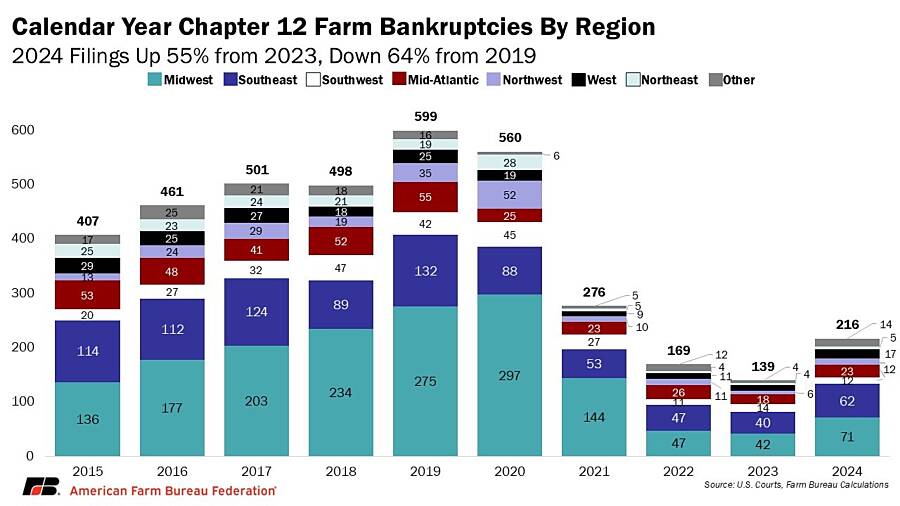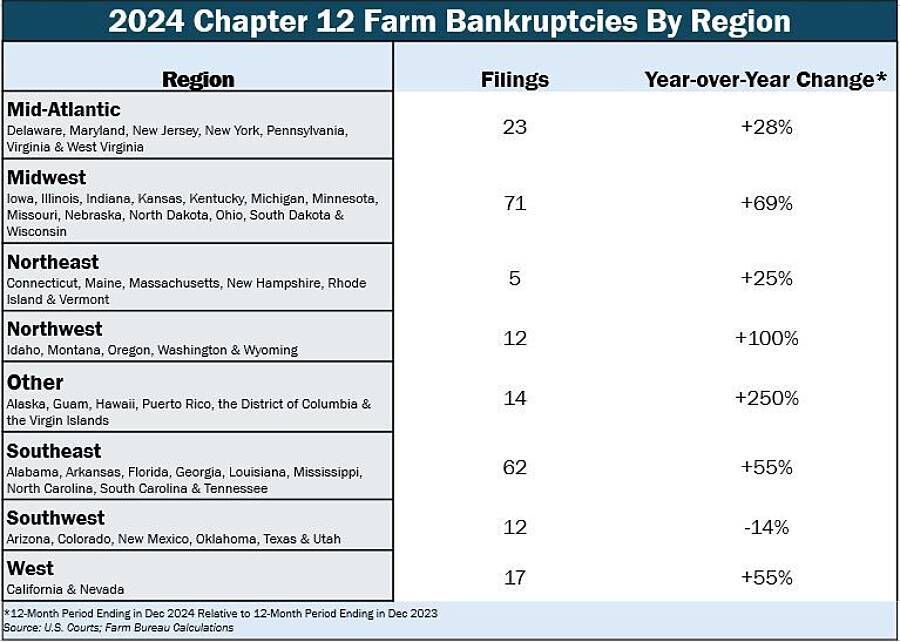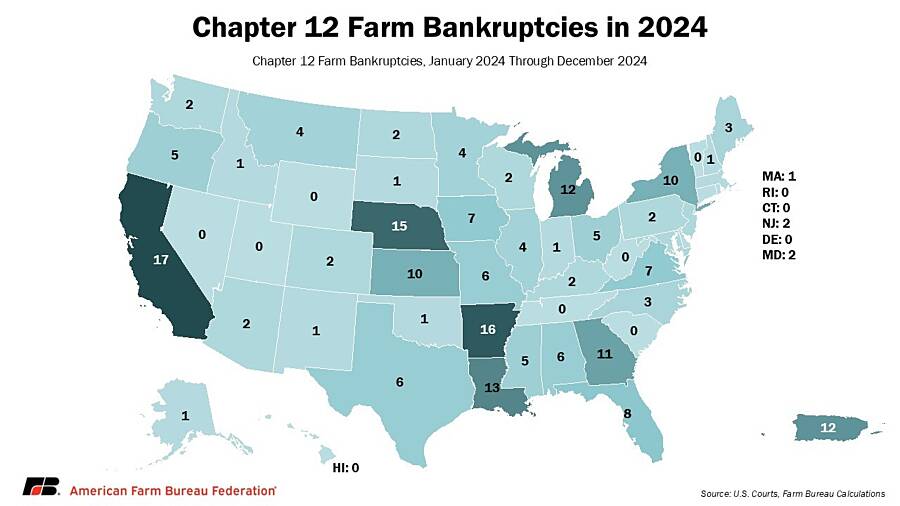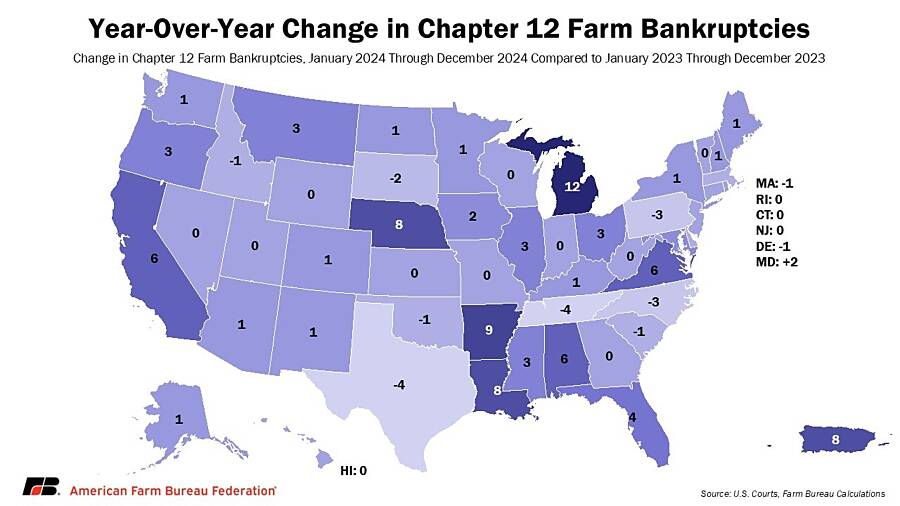2024 Farm Bankruptcies Highlight Worsening Farm Credit
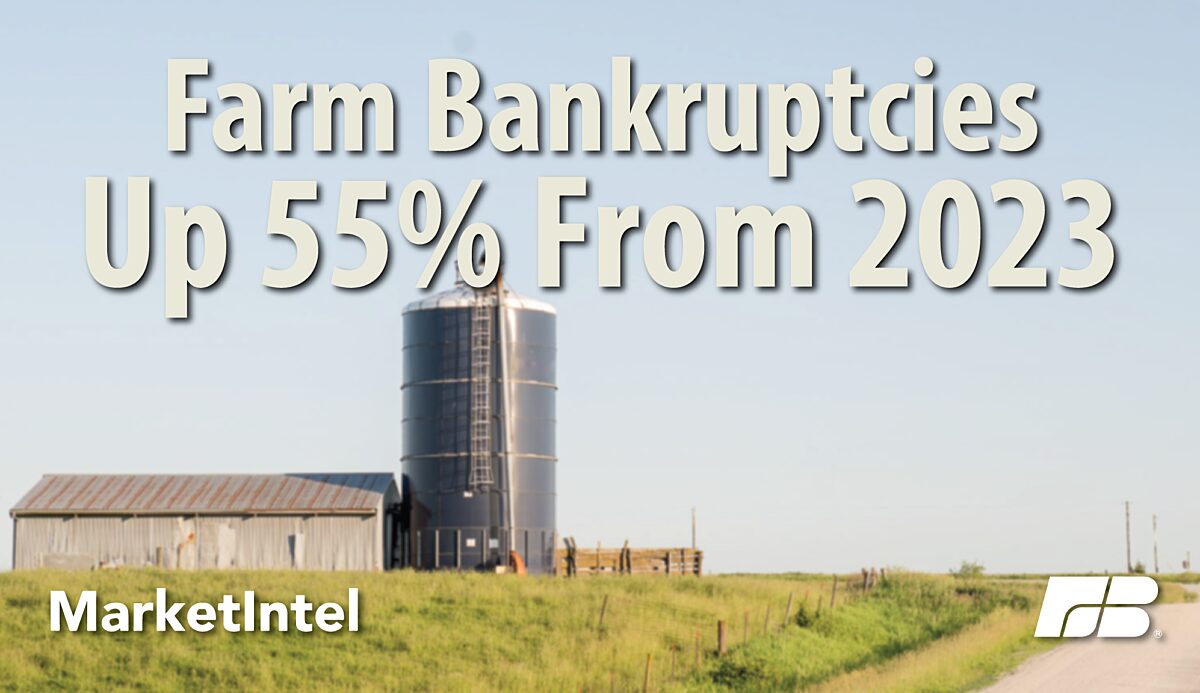
Samantha Ayoub
Economist
An indicator of farm financial health across the country, Chapter 12 bankruptcy provides farmers and ranchers with increased flexibility for paying off debt, and is used when all other options have been exhausted. AFBF Market Intel reports have long followed annual filings of Chapter 12 farm bankruptcies, through good and bad years for the farm economy.
Unfortunately, as we look ahead to another year of declining farm receipts, particularly in crop markets, we can look back to 2024 and see the impacts of that drop in income in the increase in the number of farms filing for bankruptcy.
The U.S. Courts reports that 216 farm bankruptcies were filed in 2024, up 55% from 2023. This is still 64% lower than the all-time high of 599 filings in 2019. However, 2024 is the end of a four-year downward trend in bankruptcies, which appears to mark a turning point in long-term farm financial health.
Farm Bankruptcies by Region
All but one region had increases in Chapter 12 bankruptcy filings last year. Bankruptcy filings in territories and states outside the contiguous 48 states – designated “Other” by the U.S. Courts – more than tripled in 2024, hitting a five-year high of 14 bankruptcies. However, this is still lower than any year between 2007 and 2019.
Chapter 12 bankruptcies filed in the Northwest doubled from 2023 to 2024. With 12 filings, they tied the Southwest for the region with the second fewest filings. The Southwest was the only region with a decrease in filings (down 14% from 2023) after being the only region to increase in Chapter 12 filings in 2023. After experiencing significant droughts and weather-related losses in the Southwest in 2023, all states except Utah had lower weather losses in 2024.
All other regions – Southeast, West, Northeast, Mid-Atlantic and Midwest – had double-digit increases in filings from 2023 to 2024. The number of filings in each of these regions varies drastically. The Northeast had a 25% increase to five Chapter 12 filings in 2024, one more than in 2023. The Midwest had a 69% increase in 2024 to 71 filings. The Southeast followed closely behind with 62 filings, a 55% increase.
As Row Crop Revenue Declines, Farm Bankruptcies Rise in Certain Regions
Row crop markets have experienced sharp decreases in cash receipts for three years, with expected further declines of over 4% and 6% in corn and soybean receipts, respectively, in 2025. Cotton had a nearly 24% decrease in cash receipts in 2024 but is the only major row crop forecast to post an increase in cash receipts in 2025. Chapter 12 bankruptcies lag declines in farm income as farms must exhaust their ability to pay back debt before filing. It is likely that the downward trend in net farm market returns, combined with even longer-term declines in government payments in 2024 due to an outdated farm bill, drove more farmers in the Grain Belt and South to their last resort of farm bankruptcy in 2024.
Chapter 12 Bankruptcies by State
On a state level, the total number of bankruptcies widely varies. Thirteen states/territories had no bankruptcies, while California had the most at 17.
The states and territories that had no filings in 2024 differ from 2023. In 2024, 14 states and territories had zero filings. Seven states went from having no filings in 2023 to at least one in 2024. Washington, D.C., had its first farm bankruptcy filing in the 21st century, and the first instance in the same time frame that Tennessee has not had a filing.
Only 10 states had a decrease in filings in 2024. Pennsylvania and North Carolina tied for the largest decrease in filings, three less than 2023, for both to have three filings in 2024.
Twenty-eight states and territories had an increase in filings in 2024, nine more than last year. Michigan had the largest increase in filings with 12 cases, up from zero in 2023. Eight other states and territories had double-digit filings in 2024: California (17), Nebraska (15), Kansas (10), Arkansas (16), Louisiana (13), Puerto Rico (12), Georgia (11) and New York (10).
A Struggling Farm Economy
Net farm income in 2024 reached a four-year low, decreasing nearly 24% in just two years. Lowered revenues and above-average production costs continue to squeeze farmers and ranchers on both sides of the balance sheet, threatening farm liquidity – their ability to pay off their financial obligations. As such, farm operating loans continue to surge to cover expenses.
According to the Kansas City Federal Reserve, non-real estate farm loans at commercial banks rose 25% from the end of 2023 to 2024. At the same time, interest rates on agricultural loans remain at decade-high levels. Interest expenses rose nearly 4% in 2024 to over $29.5 billion, closely following a 4% increase in farm debt in 2024. Farm debt is expected to continue to increase in 2025 to nearly $562 billion. As farms continue to carry larger debt loads without increasing net cash revenue, they also experience worsening credit. Loans across farm country, including real estate, production and agribusiness loans, increased in “less than acceptable” loan ratings, signifying a larger share of loans at risk of nonpayment. Loans facing serious risk of default in the Seventh District of the Federal Reserve, which covers much of the Midwest, rose to the highest level since 2020. Fortunately, farm delinquency rates remained under 1% in 2024.
Bankruptcy filing may not always be a solution for farms facing financial hardship. While ad hoc assistance is expected to buoy net farm income through 2025, long-term trends continue to dampen farm financials, particularly credit conditions. Nearly 2% of farmers will be unable to qualify in 2025 for the loans they received in 2024, according to the Federal Reserve Bank of Chicago. In previous years, farmers and ranchers supported their credit with continuously increasing farmland values, but those increases have slowed. The Federal Reserve Bank of Chicago’s estimates show farmland values in their district declining 1% in 2024 due to lower crop values. As farms lose options to support continued borrowing and use up their limited working capital, many farms may close before reaching the point of bankruptcy.
Conclusion
Increasing Chapter 12 bankruptcy filings provide a glimpse into the long-term conditions in farm country. Farmers and ranchers filing for bankruptcy have exhausted all other resources for covering their debt and expenses, and as the farm economy continues to be squeezed by decreased receipts and increased expenses, farm financials will be strained.
As we enter the start of another planting season, many farmers are surely making tough decisions on how to finance their operations. With all these factors in mind, they are also still waiting on the ad hoc economic and disaster aid from the American Relief Act of 2025 to be dispersed to sustain their short-term operations. Long-term, these worsening credit conditions highlight the calls for updated support for farmers as we enter the third year of farm bill negotiations.
Top Issues
VIEW ALL